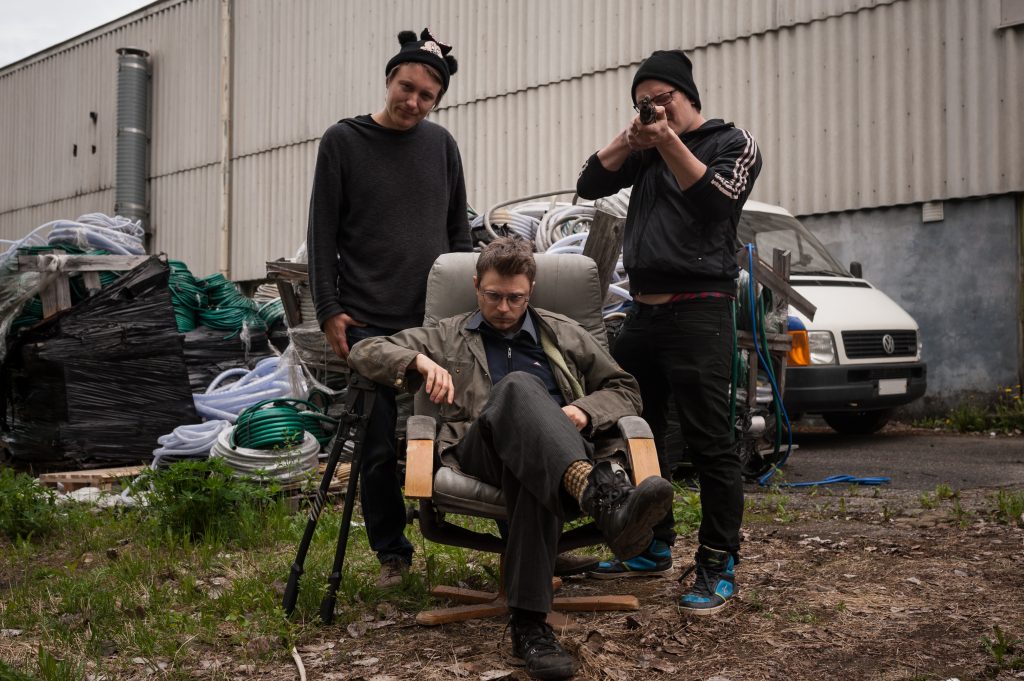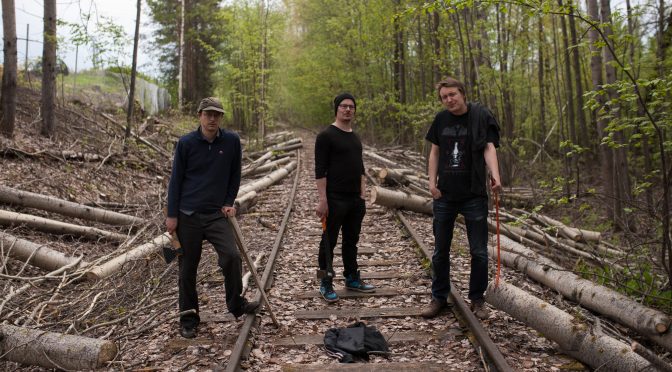Interview with Liha-Ukko (The Flesh Homunculus)
When I received your album, I was immediately drawn into the strangeness. The first song, “Seitsemäs kerros” made me feel like I was in another world. I know it is an intro and not really a song, but it makes a promise to the listener that this is not a normal album. I do not agree with any of the categories that Harmaa Getto is supposed to be in, but such things are really for only for sales. Am I correct in thinking that there is nothing else like the styles inside the album?
We are inspired by many kinds of music and come from different musical backgrounds. Our way of making music also differs from each other and the kind of sample material we used can lead to the fact that there aren’t exactly similar records. For example, Ovenvartija differs significantly from the first Harmaa Getto album, where the mood was more humoristic, alcoholic, and threatening. Now the take is more melancholic. Lauri’s other projects are a lot like Harmaa Getto, and if you listen to the albums one after the other, you can recognize a clear continuum. Harmaa Getto is a different project from Paavoharju, but they have a lot in common.
The lyrics are in Finnish. I find this to be interesting, but I wonder what people in Finland think about your album.
We frankly don’t know! Ovenvartija got little attention when it appeared, and the critics ranged from praise to scathing. Many people have said that they liked the record, but compared to, for example, Joose Keskitalo’s solos, the visibility has been weaker. We ourselves do like the record very fucking much.
” Vanhat Mestarit” gives a hint of folk music, but only in one instrument. The percussion is of the electronic realm, and the other accompaniment is very far from what can be called folk. It’s a collection of things that do not often go together. What was in your mind when you combined these different elements?
We made the whole record practically far from each other and discussed the record mostly with Lauri. We sent Lauri a lot of different material and looked at which elements worked. At least intuitively, it was clear to me from the beginning that the album had to have a dumpy, raspy sound. That’s why the album has a lot of electronic sounds. For me, combining various unrelated elements has always been fascinating and sometimes I wondered if we could have gone even further in the experiment. Fortunately, Lauri always knows how to draw the line so that the sound doesn’t go completely overboard.
“Se et ole sinä” is the first sudden jump into the bizarre. There is a calming theme, but there is a variety of distortions of the otherwise gentle sounds. The percussion seems to be pushed almost to the point of clipping, but it comes across as intentional, to add contrast to the way the main melody sounds. The occasional electric guitar parts are at full power when they come in, and they provide a tasty psychodelic flavor to an already unusual piece of music. The keyboards are set to magical settings, making it savory to listen on headphones. Can you talk about how you created this magic?
The song was probably already quite ready when I was invited to join. I had known Lauri for years, but we had never made music together. One busy morning, Lauri sent me a demo of a song that was missing keyboards and bass. Lauri asked me to try something for music. I sent all kinds of vague tapes, of which Lauri arranged the best ones. After that, I was invited to join the band. At the last minute, I think Joose played violins for this too. I guess we’ve never talked more about the meaning of the song. It’s one of my favorites on the album, and just when I imagine I’ll catch Joose’s words, the sound goes away. I heard from Lauri just a moment ago that Joose wanted to remove the song from the album in the final stages! Fortunately, this was not done!
“Aleksander Galich” has a bit more varied structure than the previous songs. I was hypnotized by every single instrument. The song created an odd mental dimension as I listened on headphones. I had a sense of hearing something that was familiar, yet everything was far from the usual way that the instruments sound. It was a joy of madness. How did this exceptional blend come together?
In the same way as all the other tracks. Lauri built the foundation on which we started playing. Galich tells the story of a real-life Russian poet who died in Europe under unclear circumstances. Joose wrote the lyrics on his own. The song on the album is not so much a political statement in one direction or another, but expresses a feeling of paranoia where you can’t trust anything; neither people nor objects in the home. That’s why the song warns in the chorus about the radio, whose electric shock is said to have killed Galich.
“Marttyyri” put me into a trance. It started as something that would be tranquil if the instruments had other settings, but the special recipe you created made the music haunting, and parts of it were melancholic, which drowned me even more. The female vocals seemed like a visitation into a dream from a ghost. The song is scary and beautiful. Each time I hear it, I visit another realm of my imagination. You give the listener a key to an inner world. What was the inspiration for this song?
For this song, we asked the genius violinist Teemu Eerola to play whatever comes to mind. He sent us several tapes that we sampled, processed, and edited to fit the song. We also asked Anniina, who is super gifted vocalist of Paavoharju, to sing background vocals for the song, which fit the pompous and paranoid atmosphere perfectly. By the way, Anniina has the main role on our upcoming Paavoharju record. You can really hear her genius on that publication. It’s also worth checking out her solos under the name Anniina Auf and, for example, in the doom metal band Mansion.
“Tuomari nostaa maljan” conitinued to intoxicate me. It began with a sense of a story unfolding, especially with the tone of the vocals. It felt like a traveler telling of his lone and slow journey. The way it ended was unexpected, except of course that it was delightfully bizarre. Please share the meaning of this song.
The song continues the same theme that Joose has sung on his own albums. The song succinctly states how the law always finds ways to judge and punish. The judge raises a toast every time he has completed his task and handed down the law. The song has a mischievously true tone.
“Keskisormi” seemed like it gave me a chance to breathe in a relaxed way as I heard a bit of spoken-word, but the female part that came in was deranged even while it was calm, and I knew that I had not yet escaped the unpredictable and intense passages. I did not translate the lyrics, but perhaps you can let me know if the words have anything to do with an altered mental state.
The song tells about an accident that happened to Lauri. As the lyrics say, Lauri had a photo of his own middle finger with a piece missing, for art exhibition. After some confusing twists and turns, the narrator runs into a person at the counter of a bar who, like the photo, is missing a piece of his middle finger.
The flute in “Joki” reminded me of a couple of songs by the band Tusmorke. Is this just a coincidence?
This needs to be verified, but with a fairly high probability it is a coincidence. In the song featuring band Mystic revelation of Teppo Repo band plays a lot of traditional music and improvisation also plays a significant role in their playing. It was originally a song made for Joose’s album, which he gave to Getto to be processed without the other members’ knowledge. We purposely made the song raucous and rough. The original version had no machine sounds or raps. We all had fun banging out the song. It still pleases me how silly it felt to produce a song for Joose with skrillex-like dubstep clichés! Joose later said that he was amused by the idea of throwing a completely finished and suitable song to the dogs.
“Ovenvartija” is a favorite song of listerners of my radio shows. One such listener, whom I call “King Adam” remarked that it sounds like the band had a lot of alcohol. I suppose that it might seem like the distorted way the world might seem in an advaned state of inebriation, but this song is not as demented as the others I have mentioned. Ovenvartija is the name of the album. What does this mean, and can you share some secrets about this song?
Joose knows best what the song means. According to my own interpretation, the song is an esoteric parody of warning songs related to various intoxicants. As such, the song does not take a stand for or against intoxicants. It’s worth listening carefully to what kind of clicks and words can be found in the background of the music.
I bought several versions of the CD, including the limited-to-200 copies. I noticed that Svart records is selling the album for a very low price. Please tell me that this is not a bad sign. I want you to make much more music.
The album has been on sale for a long time, but this has no effect on our operations. Harmaa Getto is not making music right now, and depending on Lauri, its composition may be completely different again on the next album. Now we are making a new Paavoharju record together, which will be released in the fall. We also made the Happiness album last year, which first started as the English-language Harmaa Getto album. However, the style fit better under the name Paavoharju. After Harmaa Getto, Joose has released several of his own solos and he also gigs hard. Also a moment ago, a beautiful live album from Paavoharju’s gigs was released. Something is constantly being worked on
Harmaa Getto
https://www.facebook.com/paavoharju.savonlinna
https://www.facebook.com/anniina.auf


